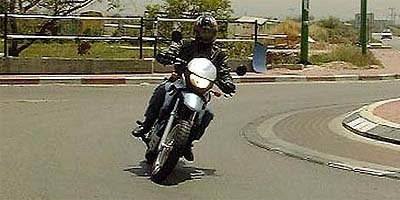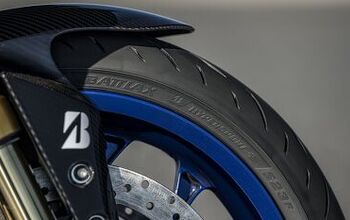Ride Report: 2000 BMW F 650 GS - Motorcycle.com
Tel Aviv, May 23, 2000 -- Radical things have been happening at BMW lately. First they re-wrote the book on cruisers with their R1200C. Then they made a stormer of a boxer sporting twin, the R1100S, and now their attention has been directed towards big singles. By reading just the spec sheets you wouldn't guess that the new F650GS is revolutionary by any means. You can go through the details in the First Look, but here are the basics for you, the lazy mouse dragger: A full downdraft intake system, an electronic fuel injection system, an under the seat fuel tank and a twin spar frame. Yep, the guys who have been known for their conservative approach have revolutionized the architecture of BMW's single cylinder motorcycle.
The guys at BMW have taken an idea present in sportbikes for the last fifteen years and applied it to a single cylinder engine. The fuel injector throat, air filter and airbox now sit were the fuel tank used to be, giving the incoming air a straight shot to the motor. The tank has moved under the seat with the added bonus being a much lowered center of gravity for the entire bike. It all makes you wonder why BMW has never implemented the idea before.
BMW has not forgotten those more inclined towards off-road adventures
Coming up with a worthy sequel for the original F650 Funduro -- a bike that sold more than 60,000 copies worldwide -- couldn't be an easy task. BMW didn't stop at their thorough engine remake, however. The frame is a totally new twin spar design. This is not a first on an off-road machine; it has been implemented before on the Honda CR250, but it is certainly new in a big trailie. To cap it all off, the designers have been let loose at their drawing boards and have created a truly impressive machine to look at. It is a strange yet captivating combination of curvaceous lines, purposeful looking parts and some really tacky details. The front end and the sexy curves around the filling cap near the rear can really make you drool, but the side grills and the big stuck-on BMW logo seem like some leftover car parts. Nevertheless, it is a head turner. I can't recall any other dual-purpose machine that has drawn so many envious looks from car drivers at stop lights.
On to the highway, then, where the engine really shines. A few bursts through the gears and the F650GS lunges to a very unstressed 100 mph. This motor is so smooth that it really makes you forget that there is just one cylinder beneath you. But the motor is not done just yet. Where other one-lunger's breathing starts to taper off, this single is just awakening on its way to a heady 7,000 rpm that translates into more than 110 mph on top. Even at this speed the motor isn't fazed. If it were a blindfold test, I could easy be suspecting that there is a twin cylinder engine hiding down there.
On my favorite mountain road, a demanding chain of decreasing radius corners with almost no straights, the BMW gives me those huge grins that are usually reserved for "exciting" machinery. The wide bars allow me to turn the bike into corners extremely quickly. Although soft, the suspension keeps the bike in control, and the Michelin T66 Radials let me get away with some silly lean angles. But all the tire adhesion in the world is useless without the excellent manners of the frame and suspension. Only when I aggressively toss the Beemer into a tight right-left chicane does the suspension lose its composure and allow the center stand grind hard.
Center stand? Yes. But this is jus t the tip of the iceberg as far as standard equipment goes. If you are used to dual purpose bikes as bare bones bikes, then the BMW is something else. Besides the center stand there is a side stand, a strengthening bridge on the fork legs, a burly sump guard, a remote adjuster for rear preload and heated hand grips. BMW's superb Anti-lock Braking System is available as an option.
Can the GS deliver in the off-road side of the dual-purpose equation? Even before the front wheel turns one revolution on dirt, one thing is for sure; you really don't want to have this beautiful bike tip over on some rocks. There's the one area where the designers might have got it wrong. The GS bodywork looks almost too fancy and fragile to get really dirty or withstand any impacts. The possible costs of repairing panels, and the total lack of knobs on the tires are in the back of my mind as I hit a very mild and hard-packed trail.
It is really at the end of the day that the broad abilities of the GS hit you. On this very day I have been running errands in city traffic, cruising effortlessly on the highway, carving some canyons and trail riding on the same machine. Although the same could be said of any dual purpose machine, the Suzuki DR650 or the Honda XL650L for instance, the BMW is head and shoulders above them as a road machine. And let's face it, that's where these sort of bikes spend 90% of their time. Besides, BMW has not forgotten those more inclined towards off-road adventures. The "Dakar" version of the F650GS is already on sale and includes longer travel suspension with stiffer springs. For the real desert racers there will be a RR version that is a replica of Richard Sainct's last Paris-Dakar rally winner.
This F650 GS is the bike that will give most of us the right balance of on and off-road abilities, albeit at a price. In some markets the GS's price is 20-30% higher than other bikes in its class. Expensive bikes usually turn me off, but this is one case where the lavish equipment level and the real-world performance justify the price tag.
Specifications
Manufacturer: BMWPrice: Not Availiable YetModel: F 650 GSEngine: Single-cylinder, Water-cooled,4-valve, DOHC, 4-strokeBore x stroke: 100 x 83 mmDisplacement: 652 ccCarburetion: EFI Bosch-BMWTransmission: 5-speedClaimed power: 50 hp at 6x.500 rpmClaimed torque: 43 ft-lbs at 5000 rpm(6 kgm at 5.000 rpm)Wheelbase: 58.3 in.i (479 mm) (58,6 in/1489mm for the Dakar)Rear Tire: 100/90 - 17 Tubeless RadialFront Tire: 130/80 - 19 Tubeless Radial (90/90 x 21 for the Dakar)Fuel Capacity: 4,57 gal. (17.3 L)Claimed Dry Weight: 388 lbs (176kg) (385.8 lbs/175kg for the Dakar)Color Schemes: Titan Blue, Red and Mandarin Yellow
More by Yossef Schvetz





































Comments
Join the conversation